 |
| 8085 arcitecture |
pin description>>
MICROPROCESSOR:
A microprocessor is a multipurpose, programmable logic device that reads binary instructions from a storage device called memory accepts binary data as input and processes data according to those instructions and provides result as output.
POWER SUPPLY & CLOCK FREQUENCY OF 8085:
The power supply of 8085 is +5V and clock frequency in 3MHz.
Applications of microprocessor-based system:
It is used:
i. For measurements, display and control of current, voltage, temperature, pressure, etc.
ii. For traffic control and industrial tool control.
iii. For speed control of machines.
FUNCTIONS OF AN ACCUMULATOR:
The accumulator is the register associated with the ALU operations and sometimes I/O operations. It is an integral part of ALU. It holds one of data to be processed by ALU. It also temporarily stores the result of the operation performed by the ALU.
16 – BIT REGISTERS OF 8085 MICROPROCESSOR:
Stack pointer (SP) and Program counter (PC).

REGISTER PAIRS OF 8085:
*B-C register pair
*D-E register pair
*H-L register pair
STACK AND STACK RELATED INSTRUCTIONS:
The stack is a group of memory locations in the R/W memory that is used for the temporary storage of binary information during the execution of the program.
The stack related instructions are PUSH & POP.
COMPARISON CALL AND PUSH INSTRUCTIONS:

COMPARISON RET AND POP:

PURPOSE OF SID AND SOD LINES:
SID (Serial input data line): It is an input line through which the microprocessor accepts serial data.
SOD (Serial output data line): It is an output line through which the microprocessor sends output serial data.
OPCODE:
The part of the instruction that specifies the operation to be performed is called the operation code or Opcode.
FUNCTION OF IO/M SIGNAL IN THE 8085:
It is a status signal. It is used to differentiate between memory locations and I/O operations.
*When this signal is low (IO/M = 0) it denotes the memory related operations.
*When this signal is high (IO/M = 1) it denotes an I/O operation.
OPERAND:
The data on which the operation is to be performed is called as an Operand.
HOW MANY OPERATIONS ARE THERE IN THE INSTRUCTION SET OF 8085 MICROPROCESSOR?
There are 74 operations in the 8085 microprocessor.
ADDRESS LINES IN A 4096 X 8 EPROM CHIP:
12 address lines.
CONTROL SIGNALS USED FOR DMA OPERATION ARE __________
Ans: HOLD & HLDA.
WAIT STATE:
This state is used by slow peripheral devices. The peripheral devices can transfer the data to or from the microprocessor by using READY input line. The Microprocessor remains in wait state as long as READY line is low. During the wait state, the contents of the address, address/data and control buses are held constant.
FLAGS:

The flags are used to reflect the data conditions in the accumulator. The 8085 flags are S-Sign flag, Z-Zero flag, AC-Auxiliary carry flag, P-Parity flag, CY-Carry flag
No comments:
Post a Comment